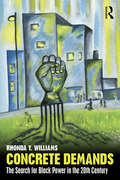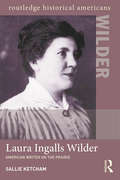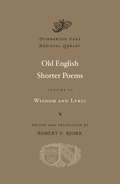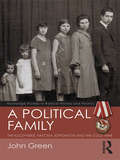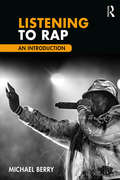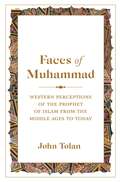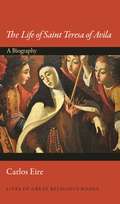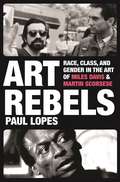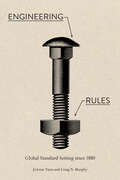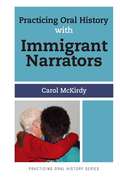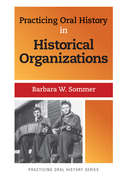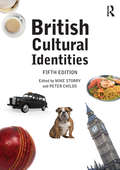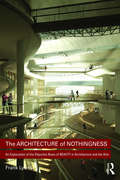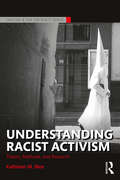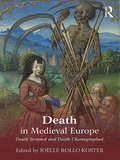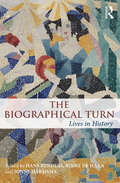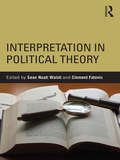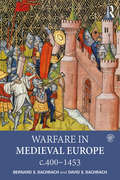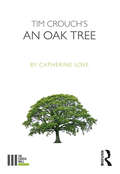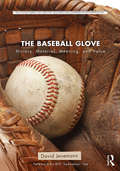- Table View
- List View
Concrete Demands: The Search for Black Power in the 20th Century
by Rhonda Y. WilliamsBetween the 1950s and 1970s, Black Power coalesced as activists advocated a more oppositional approach to fighting racial oppression, emphasizing racial pride, asserting black political, cultural, and economic autonomy, and challenging white power. In Concrete Demands, Rhonda Y. Williams provides a rich, deeply researched history that sheds new light on this important social and political movement, and shows that the era of expansive Black Power politics that emerged in the 1960s had long roots and diverse trajectories within the 20th century. Looking at the struggle from the grassroots level, Williams highlights the role of ordinary people as well as more famous historical actors, and demonstrates that women activists were central to Black Power. Vivid and highly readable, Concrete Demands is a perfect introduction to Black Power in the twentieth century for anyone interested in the history of black liberation movements.
Laura Ingalls Wilder: American Writer on the Prairie (Routledge Historical Americans)
by Sallie KetchamLaura Ingalls Wilder wrote stories that have defined the American frontier for generations of readers. As both author and character in her own books, she became one of the most famous figures in American children’s literature. Her famous Little House on the Prairie series, based on her childhood in Wisconsin, Kansas, Minnesota, and South Dakota, blended memoir and fiction into a vivid depiction of nineteenth-century settler life that continues to shape many Americans’ understanding of the country’s past. Poised between fiction and fact, literature and history, Wilder’s life is a fascinating window on the American West. Placing Wilder’s life and work in historical context, and including previously unpublished material from the Wilder archives, Sallie Ketcham introduces students to domestic frontier life, the conflict between Native Americans and infringing white populations, and the West in public memory and imagination.
Laura Ingalls Wilder: American Writer on the Prairie (Routledge Historical Americans)
by Sallie KetchamLaura Ingalls Wilder wrote stories that have defined the American frontier for generations of readers. As both author and character in her own books, she became one of the most famous figures in American children’s literature. Her famous Little House on the Prairie series, based on her childhood in Wisconsin, Kansas, Minnesota, and South Dakota, blended memoir and fiction into a vivid depiction of nineteenth-century settler life that continues to shape many Americans’ understanding of the country’s past. Poised between fiction and fact, literature and history, Wilder’s life is a fascinating window on the American West. Placing Wilder’s life and work in historical context, and including previously unpublished material from the Wilder archives, Sallie Ketcham introduces students to domestic frontier life, the conflict between Native Americans and infringing white populations, and the West in public memory and imagination.
Old English Shorter Poems: Wisdom And Lyric (Dumbarton Oaks Medieval Library #32)
by Robert E. BjorkThe twenty-five poems and eleven metrical charms in this Old English volume offer tantalizing insights into the mental landscape of the Anglo-Saxons. The Wanderer and The Seafarer famously combine philosophical consolation with introspection to achieve a spiritual understanding of life as a journey. The Wife's Lament, The Husband's Message, and Wulf and Eadwacer direct a subjective lyrical intensity on the perennial themes of love, separation, and the passion for vengeance. From suffering comes wisdom, and these poems find meaning in the loss of fortune and reputation, exile, and alienation. "Woe is wondrously clinging; clouds glide," reads a stoic, matter-of-fact observation in Maxims II on nature's indifference to human suffering. Another form of wisdom emerges in the form of folk remedies, such as charms to treat stabbing pain, cysts, childbirth, and nightmares of witch-riding caused by a dwarf. The enigmatic dialogues of Solomon and Saturn combine scholarly erudition and proverbial wisdom. Learning of all kinds is celebrated, including the meaning of individual runes in The Rune Poem and the catalog of legendary heroes in Widsith. This book is a welcome complement to the previously published DOML volume Old English Shorter Poems, Volume I: Religious and Didactic.
A Political Family: The Kuczynskis, Fascism, Espionage and The Cold War (Routledge Studies in Radical History and Politics)
by John GreenThe Kuczynskis were a German-Jewish family of active anti-fascists who worked assiduously to combat the rise of Nazism before and during the course of the Second World War. This book focuses on the family of Robert and his wife Berta – both born two decades before the end of the nineteenth century – and their six children, five of whom became communists and one who worked as a Soviet agent. The parents, and later their children, rejected and rebelled against their comfortable bourgeois heritage and devoted their lives to the overthrow of privilege and class society. They chose to do this in a Germany that was rapidly moving in the opposite direction. With the rise of German nationalism and then Hitler fascism, the family was confronted with stark choices and, as a result of making these choices, suffered persecution and exile. Revealing how these experiences shaped their outlook and perception of events, this book documents the story of the Kuczynskis for the first time in the English language and is a fascinating biographical portrait of a unique and radical family.
Listening to Rap: An Introduction
by Michael BerryOver the past four decades, rap and hip hop culture have taken a central place in popular music both in the United States and around the world. Listening to Rap: An Introduction enables students to understand the historical context, cultural impact, and unique musical characteristics of this essential genre. Each chapter explores a key topic in the study of rap music from the 1970s to today, covering themes such as race, gender, commercialization, politics, and authenticity. Synthesizing the approaches of scholars from a variety of disciplines—including music, cultural studies, African-American studies, gender studies, literary criticism, and philosophy—Listening to Rap tracks the evolution of rap and hip hop while illustrating its vast cultural significance. The text features more than 60 detailed listening guides that analyze the musical elements of songs by a wide array of artists, from Afrika Bambaataa and Grandmaster Flash to Nicki Minaj, Jay-Z, Kanye West, and more. A companion website showcases playlists of the music discussed in each chapter. Rooted in the understanding that cultural context, music, and lyrics combine to shape rap’s meaning, the text assumes no prior knowledge. For students of all backgrounds, Listening to Rap offers a clear and accessible introduction to this vital and influential music.
Faces of Muhammad: Western Perceptions of the Prophet of Islam from the Middle Ages to Today
by John TolanHeretic and impostor or reformer and statesman? The contradictory Western visions of MuhammadIn European culture, Muhammad has been vilified as a heretic, an impostor, and a pagan idol. But these aren’t the only images of the Prophet of Islam that emerge from Western history. Commentators have also portrayed Muhammad as a visionary reformer and an inspirational leader, statesman, and lawgiver. In Faces of Muhammad, John Tolan provides a comprehensive history of these changing, complex, and contradictory visions. Starting from the earliest calls to the faithful to join the Crusades against the “Saracens,” he traces the evolution of Western conceptions of Muhammad through the Reformation, the Enlightenment, and the nineteenth and twentieth centuries, and up to the present day.Faces of Muhammad reveals a lengthy tradition of positive portrayals of Muhammad that many will find surprising. To Reformation polemicists, the spread of Islam attested to the corruption of the established Church, and prompted them to depict Muhammad as a champion of reform. In revolutionary England, writers on both sides of the conflict drew parallels between Muhammad and Oliver Cromwell, asking whether the prophet was a rebel against legitimate authority or the bringer of a new and just order. Voltaire first saw Muhammad as an archetypal religious fanatic but later claimed him as an enemy of superstition. To Napoleon, he was simply a role model: a brilliant general, orator, and leader.The book shows that Muhammad wears so many faces in the West because he has always acted as a mirror for its writers, their portrayals revealing more about their own concerns than the historical realities of the founder of Islam.
Faces of Muhammad: Western Perceptions of the Prophet of Islam from the Middle Ages to Today
by John TolanHeretic and impostor or reformer and statesman? The contradictory Western visions of MuhammadIn European culture, Muhammad has been vilified as a heretic, an impostor, and a pagan idol. But these aren’t the only images of the Prophet of Islam that emerge from Western history. Commentators have also portrayed Muhammad as a visionary reformer and an inspirational leader, statesman, and lawgiver. In Faces of Muhammad, John Tolan provides a comprehensive history of these changing, complex, and contradictory visions. Starting from the earliest calls to the faithful to join the Crusades against the “Saracens,” he traces the evolution of Western conceptions of Muhammad through the Reformation, the Enlightenment, and the nineteenth and twentieth centuries, and up to the present day.Faces of Muhammad reveals a lengthy tradition of positive portrayals of Muhammad that many will find surprising. To Reformation polemicists, the spread of Islam attested to the corruption of the established Church, and prompted them to depict Muhammad as a champion of reform. In revolutionary England, writers on both sides of the conflict drew parallels between Muhammad and Oliver Cromwell, asking whether the prophet was a rebel against legitimate authority or the bringer of a new and just order. Voltaire first saw Muhammad as an archetypal religious fanatic but later claimed him as an enemy of superstition. To Napoleon, he was simply a role model: a brilliant general, orator, and leader.The book shows that Muhammad wears so many faces in the West because he has always acted as a mirror for its writers, their portrayals revealing more about their own concerns than the historical realities of the founder of Islam.
The Life of Saint Teresa of Avila: A Biography (Lives of Great Religious Books #47)
by Carlos EireThe life and many afterlives of one of the most enduring mystical testaments ever writtenThe Life of Saint Teresa of Avila is among the most remarkable accounts ever written of the human encounter with the divine. The Life is not really an autobiography at all, but rather a confession written for inquisitors by a nun whose raptures and mystical claims had aroused suspicion. Despite its troubled origins, the book has had a profound impact on Christian spirituality for five centuries, attracting admiration from readers as diverse as mystics, philosophers, artists, psychoanalysts, and neurologists. How did a manuscript once kept under lock and key by the Spanish Inquisition become one of the most inspiring religious books of all time?National Book Award winner Carlos Eire tells the story of this incomparable spiritual masterpiece, examining its composition and reception in the sixteenth century, the various ways its mystical teachings have been interpreted and reinterpreted across time, and its enduring influence in our own secular age. The Life became an iconic text of the Counter-Reformation, was revered in Franco’s Spain, and has gone on to be read as a feminist manifesto, a literary work, and even as a secular text. But as Eire demonstrates in this vibrant and evocative book, Teresa’s confession is a cry from the heart to God and an audacious portrayal of mystical theology as a search for love.Here is the essential companion to the Life, one woman’s testimony to the reality of mystical experience and a timeless affirmation of the ultimate triumph of good over evil.
The Life of Saint Teresa of Avila: A Biography (Lives of Great Religious Books #47)
by Carlos EireThe life and many afterlives of one of the most enduring mystical testaments ever writtenThe Life of Saint Teresa of Avila is among the most remarkable accounts ever written of the human encounter with the divine. The Life is not really an autobiography at all, but rather a confession written for inquisitors by a nun whose raptures and mystical claims had aroused suspicion. Despite its troubled origins, the book has had a profound impact on Christian spirituality for five centuries, attracting admiration from readers as diverse as mystics, philosophers, artists, psychoanalysts, and neurologists. How did a manuscript once kept under lock and key by the Spanish Inquisition become one of the most inspiring religious books of all time?National Book Award winner Carlos Eire tells the story of this incomparable spiritual masterpiece, examining its composition and reception in the sixteenth century, the various ways its mystical teachings have been interpreted and reinterpreted across time, and its enduring influence in our own secular age. The Life became an iconic text of the Counter-Reformation, was revered in Franco’s Spain, and has gone on to be read as a feminist manifesto, a literary work, and even as a secular text. But as Eire demonstrates in this vibrant and evocative book, Teresa’s confession is a cry from the heart to God and an audacious portrayal of mystical theology as a search for love.Here is the essential companion to the Life, one woman’s testimony to the reality of mystical experience and a timeless affirmation of the ultimate triumph of good over evil.
Art Rebels: Race, Class, and Gender in the Art of Miles Davis and Martin Scorsese
by Paul LopesHow creative freedom, race, class, and gender shaped the rebellion of two visionary artistsPostwar America experienced an unprecedented flourishing of avant-garde and independent art. Across the arts, artists rebelled against traditional conventions, embracing a commitment to creative autonomy and personal vision never before witnessed in the United States. Paul Lopes calls this the Heroic Age of American Art, and identifies two artists—Miles Davis and Martin Scorsese—as two of its leading icons.In this compelling book, Lopes tells the story of how a pair of talented and outspoken art rebels defied prevailing conventions to elevate American jazz and film to unimagined critical heights. During the Heroic Age of American Art—where creative independence and the unrelenting pressures of success were constantly at odds—Davis and Scorsese became influential figures with such modern classics as Kind of Blue and Raging Bull. Their careers also reflected the conflicting ideals of, and contentious debates concerning, avant-garde and independent art during this period. In examining their art and public stories, Lopes also shows how their rebellions as artists were intimately linked to their racial and ethnic identities and how both artists adopted hypermasculine ideologies that exposed the problematic intersection of gender with their racial and ethnic identities as iconic art rebels.Art Rebels is the essential account of a new breed of artists who left an indelible mark on American culture in the second half of the twentieth century. It is an unforgettable portrait of two iconic artists who exemplified the complex interplay of the quest for artistic autonomy and the expression of social identity during the Heroic Age of American Art.
Art Rebels: Race, Class, and Gender in the Art of Miles Davis and Martin Scorsese
by Paul LopesHow creative freedom, race, class, and gender shaped the rebellion of two visionary artistsPostwar America experienced an unprecedented flourishing of avant-garde and independent art. Across the arts, artists rebelled against traditional conventions, embracing a commitment to creative autonomy and personal vision never before witnessed in the United States. Paul Lopes calls this the Heroic Age of American Art, and identifies two artists—Miles Davis and Martin Scorsese—as two of its leading icons.In this compelling book, Lopes tells the story of how a pair of talented and outspoken art rebels defied prevailing conventions to elevate American jazz and film to unimagined critical heights. During the Heroic Age of American Art—where creative independence and the unrelenting pressures of success were constantly at odds—Davis and Scorsese became influential figures with such modern classics as Kind of Blue and Raging Bull. Their careers also reflected the conflicting ideals of, and contentious debates concerning, avant-garde and independent art during this period. In examining their art and public stories, Lopes also shows how their rebellions as artists were intimately linked to their racial and ethnic identities and how both artists adopted hypermasculine ideologies that exposed the problematic intersection of gender with their racial and ethnic identities as iconic art rebels.Art Rebels is the essential account of a new breed of artists who left an indelible mark on American culture in the second half of the twentieth century. It is an unforgettable portrait of two iconic artists who exemplified the complex interplay of the quest for artistic autonomy and the expression of social identity during the Heroic Age of American Art.
Engineering Rules: Global Standard Setting since 1880 (Hagley Library Studies in Business, Technology, and Politics)
by JoAnne Yates Craig N. MurphyPrivate, voluntary standards shape almost everything we use, from screw threads to shipping containers to e-readers. They have been critical to every major change in the world economy for more than a century, including the rise of global manufacturing and the ubiquity of the Internet. In Engineering Rules, JoAnne Yates and Craig Murphy trace the standard-setting system's evolution through time, revealing a process with an astonishingly pervasive, if rarely noticed, impact on all of our lives. Standard setting was established in the 1880s, when engineers aimed to prove their status as professionals by creating useful standards that would be widely adopted by manufacturers while satisfying corporate customers. Yates and Murphy explain how these engineers' processes provided a timely way to set desirable standards that would have taken much longer to emerge from the market and that governments were rarely willing to set. By the 1920s, the standardizers began to think of themselves as critical to global prosperity and world peace. After World War II, standardizers transcended Cold War divisions to create standards that made the global economy possible. Finally, Yates and Murphy reveal how, since 1990, a new generation of standardizers has focused on supporting the Internet and Web while applying the same standard-setting process to regulate the potential social and environmental harms of the increasingly global economy.Drawing on archival materials from three continents, including newly uncovered documents contributed by key standard setters, interviews, and direct observation of recent Web-related standard setting, Yates and Murphy describe the positive ideals that sparked the standardization movement, the ways its leaders tried to realize those ideals, and the challenges the movement faces today. An in-depth history of the engineers and organizations that developed and operate the vast yet inconspicuous global infrastructure of private, consensus-based standard setting, Engineering Rules is a riveting global history of the people, processes, and organizations that created and maintain this nearly invisible infrastructure of today's economy, which is just as important as the state or the global market.
Engineering Rules: Global Standard Setting since 1880 (Hagley Library Studies in Business, Technology, and Politics)
by JoAnne Yates Craig N. MurphyPrivate, voluntary standards shape almost everything we use, from screw threads to shipping containers to e-readers. They have been critical to every major change in the world economy for more than a century, including the rise of global manufacturing and the ubiquity of the Internet. In Engineering Rules, JoAnne Yates and Craig Murphy trace the standard-setting system's evolution through time, revealing a process with an astonishingly pervasive, if rarely noticed, impact on all of our lives. Standard setting was established in the 1880s, when engineers aimed to prove their status as professionals by creating useful standards that would be widely adopted by manufacturers while satisfying corporate customers. Yates and Murphy explain how these engineers' processes provided a timely way to set desirable standards that would have taken much longer to emerge from the market and that governments were rarely willing to set. By the 1920s, the standardizers began to think of themselves as critical to global prosperity and world peace. After World War II, standardizers transcended Cold War divisions to create standards that made the global economy possible. Finally, Yates and Murphy reveal how, since 1990, a new generation of standardizers has focused on supporting the Internet and Web while applying the same standard-setting process to regulate the potential social and environmental harms of the increasingly global economy.Drawing on archival materials from three continents, including newly uncovered documents contributed by key standard setters, interviews, and direct observation of recent Web-related standard setting, Yates and Murphy describe the positive ideals that sparked the standardization movement, the ways its leaders tried to realize those ideals, and the challenges the movement faces today. An in-depth history of the engineers and organizations that developed and operate the vast yet inconspicuous global infrastructure of private, consensus-based standard setting, Engineering Rules is a riveting global history of the people, processes, and organizations that created and maintain this nearly invisible infrastructure of today's economy, which is just as important as the state or the global market.
Practicing Oral History with Immigrant Narrators (Practicing Oral History)
by Carol McKirdyIn addition to the problem of language, conducting oral histories with immigrant narrators often requires special considerations: past violence, cultural sensitivity, and lack of trust. Yet, these narrators are often witnesses to, or participants in, important historical events, or can describe otherwise-undocumented social phenomena. The first book to focus specifically on oral history practices with immigrant narrators, it -gives both the novice and experienced oral historian insights into their narrators’ needs;-provides the tools to effectively plan and execute an oral history project in an immigrant community;-includes case studies, additional resources, and templates of important oral history processes.
Practicing Oral History in Historical Organizations (Practicing Oral History)
by Barbara W SommerIt has been half a century since the last book that addressed how historical societies can utilize oral history. In this brief, practical guide, internationally known oral historian Barbara W. Sommer applies the best practices of contemporary oral historians to the projects that historical organizations of all sizes and sorts might develop. The book -covers project personnel options, funding options, legal and ethical issues, interviewing techniques, and cataloging guidelines;-identifies helpful steps for historical societies when developing and doing oral history projects;-includes a dozen model case studies;-provides additional resources, templates, forms, and bibliography for the reader.
British Cultural Identities
by Mike Storry Peter ChildsBritish Cultural Identities assesses the degree to which being British impinges on the identity of the many people who live in Britain, analysing contemporary British identity through the various and changing ways in which people who live in the UK position themselves and are positioned by their culture today. This new edition is updated to include discussion of key events and societal shifts such as the 2016 ‘Brexit’ referendum, the 2015 British General Election, the growing emphasis on devolution, the 2012 Olympic Games, the new generation of royals, UKIP and the Euro crisis, the response to fundamentalism and the proliferation of social networking. Using examples from contemporary and popular culture, chapters cover a range of intersecting themes including: ■ place and environment ■ education, work and leisure ■ gender, sex and the family ■ youth culture and style ■ class and politics ■ ethnicity and language ■ religion ■ heritage. Accessible in style, illustrated with photographs, tables and timelines and containing discussion questions, cultural examples and suggestions for further resources at the end of each chapter, British Cultural Identities is the perfect introductory text for students of contemporary British society.
The Architecture of Nothingness: An Explanation of the Objective Basis of Beauty in Architecture and the Arts
by Frank LyonsIt is a common enough assumption that good buildings make us feel good just as poor ones can make us feel insecure, depressed or even threatened. We may instantly decide that we ‘like’ one building more than another, in the same way that without thinking we choose one work of art or music over another. But what is going on when we make these instant decisions? The process is so complex that it remains an area rarely examined, often considered unfathomable, or for some mysterious, bordering even on the spiritual. Frank Lyons seeks to unpick the complex relationships that go to make up great works of architecture, to reveal a set of principles that are found to apply not only to architecture but also to art, music and culture in general. One of the major complications at the heart of culture is that because the arts are generated subjectively, it is assumed that the finished cultural artefact is also subjective. This is a myth that this book seeks to dispel. The arts are indeed created from the personal subjective space of an individual but what that individual has to say will only be shareable if expressed in coherent (objective) form. In a nutshell, the book reverses two generally accepted positions, that the arts are subjective and that meaning is objective and therefore shared. The reversal of these seemingly common sense, but mistaken positions enables two important issues to be resolved, firstly it explains how the arts communicate through objectivity and secondly how the meaning of an object of art is never shared but always remains private to the individual. The combination of these two positions ultimately helps us to understand that beauty is a subjective appreciation of an objectively arranged form. Furthermore, this understanding enables the author to explain how a sublimely arranged form can open us to the ineffable; to a field of NOTHINGNESS, or to what some might call the spiritual realm of our own being.
Understanding Racist Activism: Theory, Methods, and Research (Routledge Studies in Fascism and the Far Right)
by Kathleen M. BleeWhite supremacist groups are highly secretive, so their public propaganda tells us little about their operations or the people they attract. To understand the world of organized racism it is necessary to study it from the inside by talking to their members and observing their groups. Doing so reveals a disturbing picture of how fairly ordinary white people learn to embrace the vicious ideas and dangerous agendas of white supremacism. This book takes the reader inside organized racism, revealing the kind of women and men who join groups, such as the Ku Klux Klan or neo-Nazi skinheads, and what they do in those groups. The volume collects significant published works from renowned scholar Kathleen M. Blee's work on racist activism, alongside new essays on the theories, methods, and approaches of studying racist activism. Discussing topics such as emotional issues in research, the place of violence and hate in white supremacism, and how women are involved in racial terrorism, Blee makes use of a range of sources, including oral histories, ethnographic observations, and interviews, to shape her findings. Written by the pioneer and leading scholar of women in racist activism, this volume is essential reading for students, scholars, and general readers interested in the areas of social movements, politics, race studies, and American history.
Death in Medieval Europe: Death Scripted and Death Choreographed
by Joelle Rollo-KosterDeath in Medieval Europe: Death Scripted and Death Choreographed explores new cultural research into death and funeral practices in medieval Europe and demonstrates the important relationship between death and the world of the living in the Middle Ages. Across ten chapters, the articles in this volume survey the cultural effects of death. This volume explores overarching topics such as burials, commemorations, revenants, mourning practices and funerals, capital punishment, suspiscious death, and death registrations using case studies from across Europe including England, Iceland, and Spain. Together these chapters discuss how death was ritualised and choreographed, but also how it was expressed in writing throughout various documentary sources including wills and death registries. In each instance, records are analysed through a cultural framework to better understand the importance of the authors of death and their audience. Drawing together and building upon the latest scholarship, this book is essential reading for all students and academics of death in the medieval period.
The Biographical Turn: Lives in history
by Hans Renders Binne De Haan Jonne HarmsmaThe Biographical Turn showcases the latest research through which the field of biography is being explored. Fifteen leading scholars in the field present the biographical perspective as a scholarly research methodology, investigating the consequences of this bottom-up approach and illuminating its value for different disciplines. While biography has been on the rise in academia since the 1980s, this volume highlights the theoretical implications of the biographical turn that is changing the humanities. Chapters cover subjects such as gender, religion, race, new media and microhistory, presenting biography as as a research methodology suited not only for historians but also for explorations in areas including literature studies, sociology, economics and politics. By emphasizing agency, the use of primary sources and the critical analysis of context and historiography, this book demonstrates how biography can function as a scholarly methodology for a wide range of topics and fields of research. International in scope, The Biographical Turn emphasizes that the individual can have a lasting impact on the past and that lives that are now forgotten can be as important for the historical narrative as the biographies of kings and presidents. It is a valuable resource for all students of biography, history and historical theory.
Interpretation in Political Theory
by Clement Fatovic Sean Noah WalshTheorists interested in learning more about any given interpretive approach are often required to navigate a dizzying array of sources, with no clear sense of where to begin. The prose of many primary sources is often steeped in dense and technical argot that novices find intimidating or even impenetrable. Interpretation in Political Theory provide students of political theory a single introductory reference guide to major approaches to interpretation available in the field today. Comprehensive and clearly written, the book includes: A historical and theoretical overview that situates the practice of interpretation within the development of political theory in the twentieth century. Chapters on Straussian esotericism, historical approaches within the Cambridge School of interpretation, materialist approaches associated with Marxism, the critical approaches associated with varieties of feminism, Greimassian semiotics, Foucaultian genealogy, the negative dialectics of Theodor Adorno, deconstruction as exemplified by Jacques Derrida and Paul de Man, and Lacanian psychoanalysis. An exposition of the theoretical and disciplinary background of each approach, the tools and techniques of interpretation it uses, its assumptions about what counts as a relevant text in political theory, and what it considers to be the purpose or objective of reading in political theory. A reading of Thomas Hobbes’s Leviathan to illustrate how each approach can be applied in practice. A list of suggestions for further reading that will guide those interested in pursuing more advanced study. An invaluable textbook for advanced undergraduates, graduate students, and even seasoned scholars of political theory interested in learning more about different interpretive approaches.
Warfare in Medieval Europe 400-1453
by Bernard S Bachrach David BachrachWarfare in Medieval Europe c. 400-c.1453 provides a thematic discussion of the nature and conduct of war, including its economic, technological, social, and religious contexts, from the late Roman Empire to the end of the Hundred Years’ War. The geographical scope of this volume encompasses Latin Europe from Iberia to Poland and from Scandinavia and Britain to Sicily and includes the interaction between Europe and the eastern Mediterranean, particularly in the context of the crusading movement. Bernard and David Bachrach explore the origins of the institutions, physical infrastructure, and intellectual underpinnings of medieval warfare and trace the ways in which medieval warfare was diffused beyond Europe to the Middle East and beyond. Written in an accessible and engaging way and including chapters on military topography, military technology, logistics, strategy and combat, this is a definitive synthesis on medieval warfare. The book is accompanied by a companion website which includes interactive maps of the chief military campaigns, chapter resources, a glossary of terms and an interactive timeline which provides a chronological backbone for the thematic chapters in the book. Warfare in Medieval Europe is an essential resource for all students of medieval war and warfare.
An Oak Tree
by Catherine LoveFirst Published in 2017. Routledge is an imprint of Taylor & Francis, an Informa company.
The Baseball Glove: History, Material, Meaning, and Value (Routledge Series for Creative Teaching and Learning in Anthropology)
by David JenemannThe baseball glove is a ubiquitous item, a crucial piece of equipment in the game of baseball, and it offers the opportunity to examine the production of material culture and social practice at numerous levels. Where and how is a glove made, and how does its manufacture square with the narratives surrounding its place in American cultural life? What are the myths, superstitions, and beliefs surrounding its acquisition, care, use, and significance? How does a glove function as the center of a web of cultural practices that illustrate how individuals relate to a consumer good as a symbol of memory, personal narrative, and national identity? How do the manufacturers of baseball gloves draw upon, promote, and in some sense create these practices? How do these practices and meanings change in other national and cultural contexts? The Baseball Glove offers students the opportunity to examine these questions in an engagingly written and illustrated book that promotes hands-on interaction with a quintessential item of material culture. At the same time, the book gives students the space for critical self-reflection about the place of material goods like sporting equipment in their lives, and it provides the chance to learn different methodological approaches to studying everyday objects.
